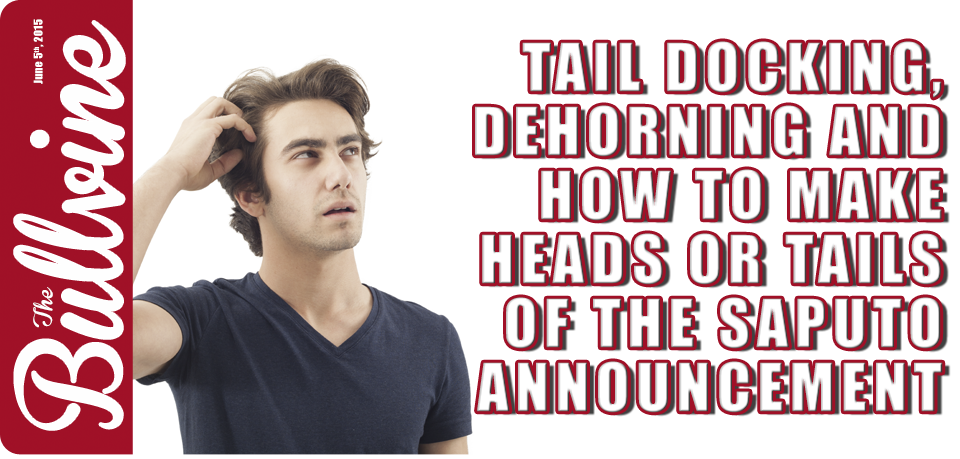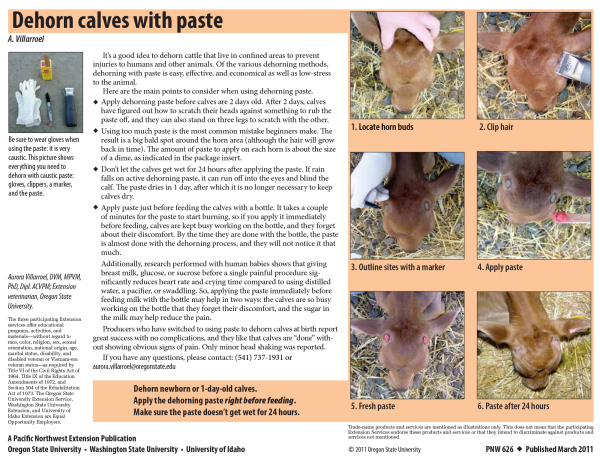Last week Saputo Inc. announced measures to control dehorning pain and to ban tail docking. (Read more: DAIRY GIANT SAPUTO MANDATES DEHORNING PAIN CONTROL AND BANS TAIL DOCKING) Company policy requirements will be put in place in response to a widely publicized video of animal abuse at Chilliwack Cattle Sales in B.C. Canada, which is a milk supplier to Saputo. (Read more: Dairy Cattle Abuse Video – A black eye for the dairy industry) Saputo is one of the three biggest milk buyers in Canada and a global company with operations around the world.
Saputo’s plan, unveiled on Monday, includes a commitment to end tail “docking” or cutting, and for the use of pain control when removing horns. The dairy company is also spending $1-million to sponsor animal-care education at two leading agricultural universities, University of Guelph in Ontario and University of Wisconsin-Madison.
A spokesman for Saputo acknowledged how they came to implement this process. “We recognized last year after the incident … that there, quite frankly, was not enough leadership in the industry to carry this issue forward. So we have taken a much more robust position.”
“The Cut Stops Here!” says Saputo. Other milk buyers to follow.
Saputo, which employs 13,000 workers at plants in Canada, the United States, Australia and Argentina, said it will require farms that are direct suppliers to follow the new policies. The Globe and Mail article also reported that Saputo will pressure milk-marketing boards and milk purchasing co-ops to encourage members to do so, as well.
The Bullvine is always pro-actively interested in initiatives that will impact the dairy industry and encourages dairy managers to evaluate what it means to them. Members of The Milk House were given the following invitation to weigh in. “Saputo has mandated dehorning pain control and banned tail docking. Do you think more dairies will follow? Does this change how you will manage your herd?” (Read more: Introducing The Milk House – Dairy Breeder Networking on Facebook)
Tail Docking Questioned? The Short Answer: “Don’t do it!”
If you are not involved in dairy farming, hearing that the tails of dairy cattle are amputated, for any reason, could be alarming. Furthermore, you might assume that everybody does it. While this practice is more common in New Zealand, it has been used, to varying degrees in other countries as well. The Milk House discussion group felt it was not as common a practice today. One herd that previously had docked tails, no longer does so and commented “we only trim switches twice a year.” Another respondent asked, “Who docks tails anymore? It’s truly unnecessary to dock tails. You say they get covered with flies if you keep their tail on, yet if you remove their tail you are removing their first defense against flies. And if you have a fly problem, get more fans in your barn. Problem solved.” In other words, if the problem is with flies or sanitation, deal with those problems before docking tails.
![Disbudding%20with%20Caustic%20Paste[1]](data:image/svg+xml,%3Csvg%20xmlns='http://www.w3.org/2000/svg'%20viewBox='0%200%20300%20171'%3E%3C/svg%3E) Cats De-Clawed. Cows De-Horned. Children restrained.
Cats De-Clawed. Cows De-Horned. Children restrained.
Most animal rights proponents are not against having cats declawed. After all, it saves the furniture and cat lovers as well from scratches. One reader saw the irony in leaving horns on dairy cattle and painted an extreme picture of the dangers that they pose. “Yep it is much better to leave the horns on and go to the sale yards and see animals bleeding because they have holes poked in their sides” Or in her own barn “I’d much rather be head butted by a heifer with horns.” She wrapped up her fearful horn wrangle with, “It would be so much fun to dangling from a bulls horns as he charges around the paddock with me.” Yes, an extreme picture but we know too well that it can happen and therefore leaving the horns on is not considered an option.
Safety in the barn and pasture has evolved in the same way that car safety has changed. Today we would not consider driving anywhere unless our children were properly buckled into their car seats and seatbelts. I have been trying to imagine the look on my parents and grandparents faces if they had foreseen that children of the future could not ride in the front seat and had to be properly restrained with buckles and belts. Alternatively, looking back, what would today’s parents think of little ones climbing over seats while the car is moving? Not to mention, my siblings and I often took turns riding in the back window!
Horn Removal! What’s the Alternative?
Several options for horn removal methods other than burning were discussed on the Milk House. Paste and drugs were two of the options. One reader noted that paste is banned in Australia.
As with all protocols, new, chosen or mandated, questions concerning the added expense for drugs, labor or vet costs, become part of the implementation issues. Added price could mean added costs to the consumer … and that too is a concern. However, if the consumer isn’t happy with the raising methods, they are less likely to choose the product. No, consumer. No, dairy business! It seems like a Catch-22 situation.
Pharmaceutical Methods of Dehorning
Several readers mentioned that they have always used a sedative and lidocaine. Medicam was more widely discussed and had several enthusiastic supporters. “It’s a great idea to use Medicam when dehorning” said some and one explained “We have used it when dehorning and there is a total difference.” The questions all boiled down to who could administer the drug and most often that means veterinarians. Some managers noted that there are differences between vet practices regarding use and approval and handing out of drugs … and who can administer them. One reader, citing their great relationship with their vets, emphasized that it’s important to discuss what it will be used for. Another outlined the logistics he uses in New Zealand, “Yes vets and/or vet assistants come and dehorn calves here – they do most of the calves in this area – I think about 120,000 last season. I even had the CEO vet come and dehorn one lot of mine last year because everyone else was busy.”
Testimonial for Medicam”
Dianna Malcolm (Blue Chip Genetics and CrazyCow in Print) also recommends Medicam. “It’s just an excellent all-round drug that is also awesome to use in conjunction with pneumonia treatments if calves are well hydrated and old enough, and colic too – among other purposes.” She urges contacting your vet and working out a protocol and a price. Dianna expanded even further. “The manufacturers of Medicam halved its price to the vets so that farmers would use it for dehorning. It is a staple drug in our fridge and very easy to get…I did a story on it in CrazyCow, and I can confirm that the difference between using it and not using it for dehorning is night and day! I’d never go back – it’s fantastic.”
One dairyman did a trial on about 120 calves for Boehringer using Medicam on every other calf. He administered three cc under the skin at disbudding. Disbudded between 2 weeks and five weeks normally. He reports “From observation calves with no Medicam kicked their heads and rubbed off gates, etc. Medicam calves gave no signs that they had been done at all. All got three cc of local anesthetic near each horn before. Growth rates averaged slightly better from birth to weaning at 56 days. Probably between 3 and 6kg a calf better than their counterparts who had sore heads for a few days after we dehorned with the burning type device, one with the screw-in gas cylinder that heats up the little cup that fits over the bud. For all the cost of doing it, roughly four bottles of Medicam a year, even if it didn’t give me better growth rates I would definitely continue it for the sake of happier calves. Happy stock is profitable stock!”
Producing a Food Product, without Consumer support, means dairying is Redundant
One reader spoke emphatically for listening to the dairy consumer. He said, “Anyone arguing against this, needs to get their head checked out. Don’t forget that we as dairy farmers, like every other business, are driven by what the consumer wants. And if Saputo made this decision in order to please the consumer then if you care at all about the economic influence that may potentially have on us, you’d stop bitching like a little school kid and change your management practices. Saputo is not saying you have to do this, only if you want to ship milk with them. If you’d rather try to sell your own milk, then best of luck on that and let me know how that works out for you”
SIDE NOTE: In this particular thread on The Milk House, no one mentioned Polled animals. Raising polled dairy cattle is as natural, pain-free and consumer friendly as it gets! And, as has been noted numerous times by The Bullvine, the genetic merit of polled Holsteins is fast catching up to that of horned Holsteins. (Read more: Polled Dairy Cattle)
The Bullvine Bottom Line
The Dairy Industry Can’t Leave Image to a Tossup between Consumers and Suppliers
These milk-buyer initiatives impact the dairy industry. It requires buy-in not only from the suppliers but buy-in from the consumers too. Milk companies are using education, protocols and training to turn around the negative impact that some animal handling practices have had on the image of the industry. They naturally have an interest in seeing that their business survives. Breeders should be interested in seeing dairying thrive. The toss up for me is, “What’s the other side of the coin if dairying isn’t a growth industry?” “Is there another side at all?
Get original “Bullvine” content sent straight to your email inbox for free.






![Disbudding%20with%20Caustic%20Paste[1]](https://www.thebullvine.com/wp-content/uploads/2015/06/Disbudding-with-Caustic-Paste1-300x171.jpg) Cats De-Clawed. Cows De-Horned. Children restrained.
Cats De-Clawed. Cows De-Horned. Children restrained.











Leave a Reply
You must be logged in to post a comment.